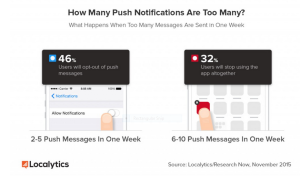Companies use mobile apps to keep customers engaged and to sell them more products. With apps come a variety of communication options, including in-app messaging and push notifications. The former is just as it sounds, allowing marketers to send targeted, personalized messages to the user based on his/her actions while using the app. The latter allows the marketer to send something to user’s home screen even if they’re not using the marketer’s app at the time. This disruption lends a certain urgency to the message, which is why many brands use this method to announce flash sales or other breaking news.
Still, disruption and urgency can quickly lead to irritation, and so push notifications must be used sparingly. Localytics found that almost half of users will opt-out if they receive 2 to 5 push messages in one week. Send 6 to 10 pushes in a week, and consumers will push your app right off of their phones, deleting it completely.

Too many notifications can push customers to delete an app.
Of course, there are also those customers who never opt-in to pushes in the first place. A 2015 Urban Airship study found that only 42% of app users were opting in to push notifications. Some app categories saw opt-in rates as low as 33%.

Overall opt-in rate for mobile push notifications is 42%.
Given that, we’d all do well to remember what Marketing Land is telling us – “Above all, you should remember the key to success — don’t be annoying and use each push strategy sparingly with value-based content to get the best results over time.”
How do you feel about mobile push notifications as a marketer? As a consumer?
So that’s what those annoying ads that show through on apps that I am using are called. I just totally ignore them as they are not the reason I am using specific apps in the first place. Some apps require you to pay to avoid seeing the ads and others state the ads are their “bread and butter” in order to make the app free for you to use. Compared to the web, I think it is more difficult to avoid apps on mobile devices compared to that of your laptop and/or desktop per se. I would like to know where these choices are located to opt out of push notifications because I have never seen them before. This post was interesting as I have learned something new but now require more so I can choose when and how often marketers can approach me digitally.
LikeLike
Hey! I think you’re referring to your experience with mobile ads. They pop up all the time when I’m using free versions of software. Push notifications are the alert you receive on the lock screen or notifications view of your device. If you visit the settings for that app, you can change your preference for receipt of notifications. Hope this helps!
LikeLike
Push notifications are a marketers dream! It’s an opportunity to connect with consumers on a recurring and consistent basis, through a channel they are already interested in. I agree that direct connection can easily ruffle a consumer trying to stay engaged with the very app they downloaded in the first place. I generally go and turn off push notifications when I begin to notice the alerts too often for apps that I feel unnecessarily send out notifications. I can’t say that I’ve ever deleted an app because of the notifications because for me, the reward of having the app, often outweighs removing it from my device altogether.
LikeLike
I have two recent experiences. I signed up to Home Depot SMS messages a year ago. I get one offer every week. I like this and while I rarely use it, they have not pushed too much that I feel the need to turn it off. I also recently downloaded the App to watch the Masters golf tournament. I received push notifications several times and hour – so I turned them all off. I’m sure I was less engaged due to turning it off, but it was too much and the value was not there. Brands need to know what notifications users value and allow users to control the frequency. What if the user determined the frequency?
LikeLike